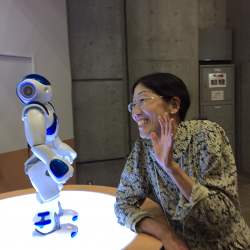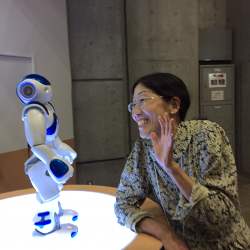
"Japan Robot Week is your ticket to uncanny valley. …Admission is ¥1000, but visitors can get in for free if the register beforehand." Japan Times, Oct. 2, 2014
It all began with an innocent perusal of my daily newspaper; the photo of a pair of robots in a stylish, but contrived, adolescent-like pose caught my attention. A few days later, I hopped on a train to Tokyo Big Sight in hopeful anticipation of meeting Nao, a 58-cm-tall humanoid robot from Aldebaran Robotics. The three-day Robot Week Expo in mid-October attracted 4,597 visitors on the first (very rainy) day, and 5,892 and 6,137 on subsequent (sunny, warm) days, for a total of 16,626 visitors. The Expo featured booths with demos, as well as talks and panel discussions. I spent a day watching demos and actively interacting with robots in booths that encouraged visitor participation.
Inside the Expo, the atmosphere was typically Japanese engineering. Just beyond the entrance was a booth with many clones of Nao in various colors of the rainbow, ready to greet visitors. A friendly coach instructed a blue-colored Nao to strike different athletic poses using voice recognition: "soccer," "baseball," "volleyball," … The area was congested with fans snapping photos with cameras and cellphones. I maneuvered through the crowd and proceeded to the main exhibition area.
Modern Industrial Robots
As expected, a major portion of the floor was devoted to industrial robots performing relatively mundane, menial tasks. However, unlike their predecessors, these were more like creatures than inanimate objects. Some had human-like hands for performing intricate manipulations – all controlled by software based on real-time, sensory feedback algorithms. The fine movements of the fingers, such as pressure applied when grabbing objects were not complete, pre-programmed movements. Instead, they were determined by "feelings" when grasped by a robotic hand. These sophisticated, modern robots demand a high initial capital outlay, however, they can be cost effective over the long-term. Re-programming them to perform different tasks can obviate the need for major re-tooling following changes in product design. Moreover, these software-controlled robots open up the possibility of making small but timely and critical modifications in products based on customer feedback that would be have too expensive to consider in the past.
To encourage active discussion on the future role of intelligent and nimble robots in society, Kawada Industries brought along Nextage, a barista robot. The not-quite-humanoid gently performed intricate tasks that used to require humans. I caught up with Yukiko Hoshino, chief engineer of the software team that brought the robot’s skillful performance to life; she reassured me that Kawada has no plans to manufacture clones of Nextage to replace human workers. She felt that realistic, future scenarios would be limited use of robots in the workplace during peak periods (e.g., breakfast and lunch times in cafés) when human workers are overwhelmed by sharp spikes in customer demand. A second purpose for the barista’s appearance was to create media buzz; that it did. Fans and the press clamored around the makeshift café to watch the robot accept a customer order through a menu on a tablet PC and prepare a hot drink using a Nespresso machine and capsule. The current prototype, though very quiet and well-mannered, moves so slowly that customers in need of a caffeine fix are likely to fall asleep before their drinks arrive. A video of Nextage at work is available on on-line.
Robots and Seniors
A second major theme was care for the elderly with: devices to enable or expedite rehabilitation; tools for facilitating daily chores, and technologies to support emotional well-being. A number of companies and universities developed a variety of wearable robot suits (a.k.a. exoskeletons) to assist workers with heavy manual labor, e.g., in factories, delivery services, and nursing homes. Visitors were encouraged to try on Muscle Suit, an exoskeleton from Innophys, to experience its helpfulness when lifting a huge sack of potatoes. I had high hopes as I queued up to give it try since I am, literally, a classic 99-pound weakling. However, my fantasies of donning the power suit, sprouting artificial muscles, and adroitly lifting the potato sack were not to be; experts in the booth informed me that exoskeletons are designed to support existing capabilities of users, so my maximum lifting weight would remain unchanged. Furthermore, the suit is designed for sturdier users, so it would not fit me properly.
Many companies and universities had demos of exoskeletons for legs to aid in rehabilitation of seniors who trip, fall, and break their leg bones; many die from the disruption to their lifestyle, rather than the injury itself. Simple and quick rehabilitation is known to be the key to ensure recovery that maintains a high quality of life. The most dramatic demo in this category was Tokyo University of Science’s system to pull "terminally" bed-ridden patients out of bed, prop them upright, and help them stand and walk. A human physical therapist must help patients buckle into the machine, stand upright, and get out at the end of the session. One short-term goal is to help patients stand and move to a portable, flushable toilet by their bedside. This would enable them to live at home with relatives, and free them of issues with bedpans, bedsores, etc.
A more low-key but equally significant demo was a wearable device for microsurgeons. Visitors could try out a support skeleton, designed to help steady hands and reduce fatigue during demanding, emergency surgeries that typically last several hours, sometimes well over a half-day.
Chiharu Ishii of Hosei University and his students (Gakuto Komada, Takeshi Kikuchi, et al.) developed a system to control and drive wheelchairs using facial and neck muscles, enabling people paralyzed below the neck to move about on their own. As demonstrated by a student, sensors to communicate with a controller are placed on the cheek and neck using off-the-shelf, two-sided adhesive tape. Their work was inspired by studies of stroke victims that found most do not want to rely on others; their feelings of helplessness and guilt for burdening their families sometimes led to severe mental stress and depression.
Another booth by university researchers featured exploratory work on developing artificial muscles for human limbs to replace those that have atrophied. They developed synthetic fibers each of which mimic human muscle cells. Current synthetic fibers are much thicker than their biological counterparts, so artificial muscles with the same number of cells are too big to be of practical use, but an important first milestone has been reached.
Robotic Aid in Post-Disaster Recovery
A third theme at the Expo was post-disaster recovery. Research in this area has enjoyed a surge in funding by the Japanese government after the triple disaster following the Tohoku earthquake. Japanese were dismayed to find their loss in leadership in robotics research when they needed to rely on foreign robots to survey areas near and within the Fukushima nuclear power plant. Since then, public support for increased funding in robotics remains strong.
Many university teams targeted design of inexpensive, easily assembled robots, built from off-the-shelf materials, with friendly user interfaces that require minimal training of non-scientists. Interestingly, many teams modeled their robots after small creatures that can adeptly move about harsh terrains. For example, Tetsushi Kamegawa’s team at the University of Okayama built a small, snake-like creature that can crawl through horizontal and vertical pipes and move through small crevices. When a tiny video camera is mounted on the snake, it enables disaster recovery teams to check out a scene without human entry to a site. The snake is controlled using a video game handset, and visitors of the booth were welcomed to try it out.
Another university developed a six-legged robot modeled after spiders for crawling and around disaster sites with a video camera. In theory, only four legs are needed for stable movement, but spare limbs add stability while traversing of bumpy terrains and decrease the possibility of a mechanical breakdown.
Japanese companies have also entered this arena, but in a more grandiose fashion. Mitsubishi Electric Tokki Systems Corporation demonstrated Frigo-M, a 23kg mini tank-like contraption that is currently moving about (and up and down stairs) at the Fukushima nuclear site, collecting data.
Robots for Entertainment and Companionship
A fourth major theme at the expo was entertainment and companionship for seniors living alone. Many could only be described as embodiments of the Japanese concept of "kawaii" (cute). Some were marketed as a multi-purpose robot, like Kobochan, a talky stuffed toy that alerts caretakers when patients wake up in the middle of the night; Palro, a humanoid robot that reads the morning paper aloud, sing songs, and leads users through the infamous radio-taiso (ラジオ体操) morning calisthenics broadcast daily by NHK radio at 6AM, and BIOLOID STEM, which claims to teach how to assemble robots using a DIY kit, and to program them. Without a doubt, the media darlings were Robi Jr. and his pet dog; the pair was marketed as affordable entertainment/toys for the holidays.
A final must-mention is speculation on the role on robots in the 2020 Tokyo Olympics. Recall that Japan’s introduced Mirata, the talking robot, who greeted the public during at a news conference during the Olympic bidding process. Bets are on that glamorous and sophisticated, high-end humanoids will work along low-cost robots performing relatively mundane tasks to showcase Japan’s technical prowess while keeping the overall budget for the event under control.
Conclusion
I did not major in engineering or CS. I set off to Big Sight unsure of the worthiness of a trek to the Robot Expo; nevertheless, I had a fantastic time. I learned that modern robots are not all about hardware. Bringing high-end robots to life requires the ingenuity of highly skilled software engineers working closely with their counterparts in hardware. Continued collaborative work between HW and SW engineers will undoubtedly enable robots of the future to move "naturally" at the same speed and nimbleness as humans in the not-too-distant future …, and who knows what else?
As I was leaving, I turned back to wave good-bye to Nao-chan: "Sayonara for now (pictured at the top). I look forward to meeting your younger siblings and children at future Robot Expos."
Mei Kobayashi holds a Ph.D. in Pure and Applied Mathematics; her research interests include computational chemistry, numerical analysis, signal processing, and data mining.




Join the Discussion (0)
Become a Member or Sign In to Post a Comment